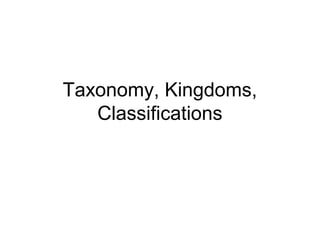
Classifications
- 1. Taxonomy, Kingdoms, Classifications
- 2. • To study the diversity of life, biologists use a classification system to name organisms and group them in a logical manner • Binomial nomenclature: two part scientific name: first part is the genus (closely related species) – second part is name unique to the species • Ex: Ursus maritimus
- 3. Carolus Linnaeus (1707-1778) • Hierarchical system of classification with 7 levels: ordered from smallest to largest • Species, genus, family, order, class, phylum, and kingdom (animalia, plantae) • Organisms were grouped based on visible similarities and differences
- 4. Evolutionary classification • Phylogeny – evolutionary relationships among organisms (Darwin) • Organisms are grouped into catagories that represent lines of evolutionary descent and not just physical similarities (evolutionary classification) • Derived characters; appear in recent lineage but not in older member
- 5. Cont. • Derived characters can be used to construct a cladogram, a diagram that shows the evolutionary relationships among a group of organisms
- 6. DNA and RNA • Genes of many organisms show important similarities at the molecular level. Similarities in DNA can be used to help determine classification and evolutionary relationships • Molecular clock – uses DNA comparisons to estimate the time that two species have been evolving independently
- 7. Kingdoms • First - Animalia and plantae • Additional – Monera (split into Eubacteria and Archaebacteria), Protista, Fungi, • Current classification has the above 6 kingdoms • Domain – 3 categories (larger than kingdom) • Bacteria • Archaea • Eukarya
- 8. Domains 3 categories (larger than kingdom) • Bacteria – unicellular, prokaryotic • Archaea – extremophiles • Eukarya – all organisms that have a nucleus
- 9. Protist: • Protista – means “very first” 1.5 billion • Margulis – evolved from mitochondria and chloroplasts found in eukaryotic cells may have descended from aerobic and photosynthetic prokaryotes that began to live inside larger cells • Protista - Eukaryotes that do not belong to plantae, animalia, fungi or a prokaryote
- 10. Cont. • Has nucleus and membrane-bound organelles • Most unicellular • Animallike: heterotrophs, • Plantlike: autotrophs • Funguslike: decomposers
- 11. Fungi • Heterotrophs • Absorb nutrients (hyphae/mycelium) • Have cell walls (chitin) • Reproduced with fruiting body • Asexually – hyphae break off and grow or spore production • Two mating types (+) and (-) meet, fuse, diploid zygote enters meiosis and completes reproduction.
- 12. Plantae • Multicellular eukaryotes that have cell walls made of cellulose, carry out photosynthesis (trees, shrubs, grasses, mosses, ferns) • Life cycle has 2 alternating phases: • Diploid (2N) – sporophyte (spore producting) • Haploid (N) – gametophyte (gamete producing)
- 13. Survival • Sunlight • Water and minerals • Gas exchange • Transport of water and nutrients • Evolved from early multicellular green algae
- 14. Animalia • Multicellular, eukaryotic heterotrophs lack cell walls • Invertebrates – no back bone (squid, sea stars, microrganisms) • Vertebrates – with back bones (humans, reptiles, birds, mammals)
- 15. Survival • Homeostasis – stable state maintained by feedback mechanisms • Feedback inhibition – product or results stops process or limits the process • Feeding - nutrients • Respiration – transport of gases (O2 and CO2) • Circulation – movement of material in organism
- 16. Cont. • Excretion – removal of waste products • Response – nervous systems (stimuli) • Movement – muscle or muscle-like tissue that allows for mobility • Reproduction – production of offspring (usually through sexual reproduction)
- 17. Animal evolution • Complex animals tend to have high levels of cell specialization and internal body organization, bilateral body symmetry, front end or head with sense organs (cephalization), and body cavity • Cell → tissue → organs → organ systems
- 18. Sponges • ancient animals • Multicellular, heterotrophs, with some specialized cells, asymmetrical • Movement of water through a central cavity provides a simple mechanism for feeding (filtering), respiration, circulation, excretion
- 19. Cnidaria • Soft-bodied, carnivorous animals with stinging tentacles arranged in circles around their mouths, simplest animals to have body symmetry and specialized tissues • Life cycle: polyp and medusa • Jellies, hydras, anemones,